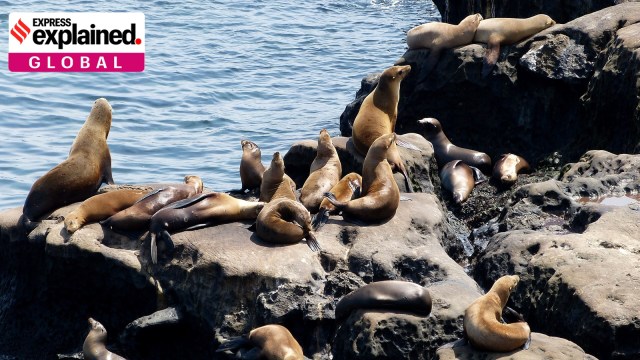The worst affected are marine mammals. More than 20,000 sea lions and a handful of dolphins have died in Chile and Peru due to the infection. There have been reports of deaths of seals on the east and west coasts of the US.
Written by Alind Chauhan
New Delhi | Updated: March 28, 2024 12:29 IST


 Tens of thousands of seals and sea lions in different parts of the world have recently died due to the bird flu. (Representational image/Wikimedia Commons)
Tens of thousands of seals and sea lions in different parts of the world have recently died due to the bird flu. (Representational image/Wikimedia Commons)
Since 2020, a highly pathogenic type of bird flu, H5N1, has been spreading across the globe, posing an existential threat to birds and wildlife. The virus has infected birds in more than 80 countries (as of December 2023) and resulted in culling of millions of chickens and turkeys at commercial poultry farms. It also struck numerous species of wild birds, such as gulls and terns, killing them by thousands.
javascript:false
The more worrying sign, however, is the rapid spread of the flu — once largely confined to birds — among mammals. For instance, tens of thousands of seals and sea lions in different parts of the world have died due to the disease. The infection has also infiltrated mainland Antarctica for the time in history.
In January, Dr Chris Walzer, the Wildlife Conservation Society’s Executive Director of Health, in a statement, said: “It (H5N1) has infected over 150 wild and domestic avian species around the globe as well as dozens of mammalian species. The bird flu outbreak is the worst globally and also in US history, with hundreds-of-millions of birds dead since it first turned up in domestic waterfowl in China in 1996.”
ADVERTISEMENT


https://imasdk.googleapis.com/js/core/bridge3.629.1_en.html#goog_324837100
Here is a look at what bird flu is, how it is impacting different kinds of animals, and why the virus is spreading at such a large scale.
What is bird flu?
Bird flu, also known as avian flu, refers to an infectious viral illness that mainly infects and spreads among poultry and some wild birds. There are different strains of bird flu virus, which have been circulating for a very long time among at least 100 bird species, including wild waterfowl, such as ducks and geese, without much harming them.
From time to time, a form of the flu virus jumps from wild birds to poultry farms, and replicates in cramped warehouses of farmed birds. It then quickly evolves into a highly pathogenic flu virus that causes a larger wave of illness and death than usual among birds.
The currently circulating type of H5N1 is one such highly pathogenic flu virus. It has “descended from a virus that caused an outbreak on a goose farm in Guangdong, China, in 1996. That virus — one of a type of virus known as H5N1 — was highly pathogenic and killed more than 40 per cent of the farm birds it infected,” according to a report by Vox.
ADVERTISEMENT
The new version of H5N1 first emerged in Europe in 2020 and then rapidly reached Europe, Africa, and Asia. By late 2021, it had spread to North America and in the fall of 2022, it appeared in South America. In February 2024, the virus stormed through mainland Antarctica.
Also in Explained | Coronavirus: Why bats carry viruses but don’t fall ill themselves
How has H5N1 impacted animals across the world?
Apart from the farm birds, the virus has severely impacted wild birds. “First, Great Skuas began dying across islands in Scotland in summer 2021,” according to a report by the Royal Society for the Protection of Birds (RSPB). “Then in winter 2021/22 on the Solway Firth, bird flu killed a third of the Svalbard breeding population of Barnacle Geese – at least 13,200 birds. In winter 2022/23, up to 5,000 Greenland Barnacle Geese died on Islay, as well as hundreds of ducks, swans, gulls and other geese species. Birds of prey such as Peregrine Falcon, Hen Harrier, Buzzard, White-tailed Eagle and Golden Eagle have also been testing positive.”
Some wild birds, which are already on the verge of extinction, have also been hit. At least 21 of the endangered California condors have died from the virus in 2023 alone, which is nearly 6 per cent of the population of the roughly 330 birds that were believed to live in the wild as of the end of 2021, according to the US National Park Service, The Wildlife Society said.
The biggest concern is the spread of the virus among mammals, though. Outbreaks among foxes, pumas, skunks, and both black and brown bears in North America have been reported. In Spain and Finland, farmed minks have been infected. A report by Forbes said: “This is especially dangerous because these small mammals — which, like poultry, are kept in filthy, overcrowded and unhealthy conditions — provide ample opportunities for viral reassortment so it can easily begin to infect other mammals… whilst simultaneously increasing its virulence.”
ADVERTISEMENT
Also in Explained | Bird species plummeting in India, says new report: What are the major threats to them?
The worst affected are marine mammals. More than 20,000 sea lions and a handful of dolphins have died in Chile and Peru due to the infection. There have been reports of deaths of seals on the east and west coasts of the US. Thousands of elephant seals have also been killed in Argentina.
In his statement, Dr Walzer said: “Sampling efforts suggest that more than 95 per cent of the Southern elephant seal (Mirounga leonina) pups born along 300 km of the Patagonia coastline (southern end of South America) died at the end of 2023. It’s the first report of massive elephant seal mortality in the area from any cause in the last half-century. The sight of elephant seals found dead or dying along the breeding beaches can only be described as apocalyptic.”
Humans are also at risk but they rarely contract bird flu. Most of the cases of human infection involve people who have come in contact with a large number of sick birds at poultry farms. This means that humans are likely to get infected when there is a huge viral load.
What’s behind the large-scale spread?
The exact factors behind the large outbreaks of the bird flu are still largely unknown. Some scientists, however, suggest that one reason could be climate change.
ADVERTISEMENT
According to studies, soaring global temperatures impact the behaviour of birds in such a way that it exacerbates the spread of the flu. These birds are forced to move into new territories and mix with species that they usually don’t interact with, which possibly boosts the chances for the virus to spread even further.
Higher sea surface temperatures might also be at play. For example, warmer sea temperatures near northern Chile have led to a fall in the forage fish population and that has made sea lions weaker and more susceptible to disease, Liesbeth van der Meer, director of the environmental group Oceana in Chile, told the Associated Press.
